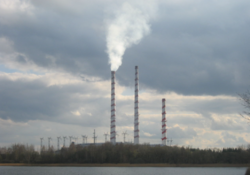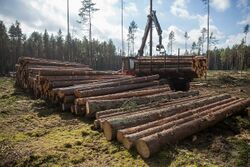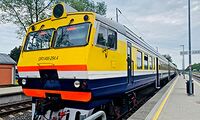Baltica: Difference between revisions
No edit summary |
|||
| Line 123: | Line 123: | ||
===Environment=== | ===Environment=== | ||
The primary territory of Baltica lies on what is known as the Western Lake Plains, with a majority of the nation being comprised of wetlands and flatlands. Roughly 21% of all land in Baltica is comprised of Swamps, Marshes, Flood plains and bogs. This is a large decrease from the once 34%, which is often attributed to both the Baltican civil war, rise of industries and the draining of these areas to make the land for cities as well as agricultural land. Besides wetlands, forests make up the other large majority of land in Baltica, making up about 41% of all land in Baltica. The largest natural forest remains the Draigai Forest, which at one point used to be much larger but due to logging in the recent decades has greatly diminished in size. However, most of these forests can only be found in Western or Northern Baltica, as areas like Visagris had undergone large deforestation and land transformation during the 1970s. Although new legislation exists to prevent the type of deforestation Baltica experienced during the late 20th century, logging and land transformation remains rapid in some regions, and the yearly loss of both forests and wetlands is still quite high. | |||
[[File:Baltican Flatland.jpg|thumb|1100px|center|Flatlands near the city of Kauni]] | |||
Rivers are quite abandoned in Baltica, with over 300 rivers flowing all over the nation, the largest of which are the Kauni river in Western Baltica as well as the Uzli river in Northern Baltica. Balticas rivers have largely been uncontaminated by pollution, largely because of the lack of real industry on rivers as most Baltica industry is located on the Amber lake. Most of these rivers originate from mountains outside of Baltica itself, mainly around the Western Misty Mountain Range that makes up the Western border of Baltica. Rivers in the East mainly originate from internal Lakes and flow out into the Amber lake as well as other lakes. A few Northern Rivers originate from the Nation of Mokhavia, and Balticans Eastern border is comprised of the Belgorta river. | |||
==Politics== | ==Politics== | ||
Revision as of 16:06, 16 February 2022
Republic of Baltica Baltijos Respublika | |
|---|---|
Motto: "If god is with us, who is against us ?" | |
Anthem: "The March goes on" | |
| Capital | Goja |
| Largest city | Goja, Kauni, Kretia |
| Official languages | Baltican Dolch, Ras, Dolch |
| Ethnic groups |
|
| Demonym(s) | Baltican |
| Government | Republic |
• President | Algridas Banis |
| Legislature | The National Council |
| General Council | |
| Regional Council | |
| Independent | |
• 1143 AD | 1961 AD |
| Population | |
• 2019 estimate | 14,821,213 |
• 2020 census | 14,800,312 |
• Density | 43/km2 (111.4/sq mi) |
| GDP (nominal) | 2018 estimate |
• Total | 90,213,343 |
• Per capita | 11,213 |
| HDI (0.68) | 0.67 medium |
| Currency | Zedai |
| Date format | dd/mm/yyyy |
| Driving side | right |
| Internet TLD | .Ba |
The Republic of Baltica or simply Baltica, is a “republic” located on the continent of Argis, specifically around the great lakes region. It is home to 14.8 Million people, and has a GDP of 90 Billion Baltica Zeidas. The Capital of Baltica is Goja, which is also its largest city, with over 700 thousand inhabitants.Currently its divided into 29 states, the largest of which remains Kauni County with over 1.9 million people within it. Today its main industries include its large agricultural sector as well as its emerging timber business.
Baltica is currently ruled by President Algridas Banis, who has been president of Baltica for over 33 years. Many would describe Baltica as a “dictatorship” which it is, but surprisingly it continues to boast a somewhat high level of political freedom, with the citizens having access to freedom of speech, the ability to elect local county mayors and choose members for the "Regional Council of Aestia".It currently borders the Nations of Mokhavia to the North, Transbaltia to the South and Fina to the east
History
Prehistory
Most of Balticas initial settlement came from the migration of the “Balts”, who according to speculation, was the group or a collective of tribes that are the possible ancestors of the modern-day Ras and possibly Latovians in neighbouring Transbaltia. Although it is unknown when they entered modern-day Baltica, scientists have been able to locate what they call the “first settlement by the Balts in Baltica, this being the Vargas valley in modern-day Kauni county.
Modern-day excavations along the Central Baltican highlands as well as the Northern wetlands suggest that most of the old balts had been a largely ununified group, but had somewhat formed into a distinct culture, separate from the Latovians . This first group had no written language, so little is known about them, however, they were prone to carving “wards and “totems, most of which have been destroyed ( because they were carved out of wood) but some stone carvings exist to this day. The first written source of the modern Ras, came from the Dolchic, who would write about the Ras during their conquest of Baltica. This suggests that the Ras came after these previous Balts, although it's still unknown when the Ras would form into their culture group or even how they came to be the “only” culture group in Baltica, it's heavily suggested that they were a warring people, who either assimilated or killed of all other Baltican tribes within the region.
Dolchic Invasion
Almost no information exists on the Ras before the beginning of the conquest of the Dolchic. All that is known about them comes from oral history, which tells of the Ras being an almost nomadic people, who would migrate through the dense forests of Baltica in search of pasture land. This is how they would come to settle the modern-day Lake Gintara (Lake Amber), as they would migrate from the Western Region of Kauni, to Greater Kretia. Of course, this peaceful existence would come to an end during the invasion of Dolchic. The Dolch would first land in the region of Goja, and would subsequently set up the city of Goja. Their invasion would bring many new technologies, culture, and even faiths to Baltica.
The Dolch invasion was quick and vicious. Over 50 years, they would conquer large areas of the greater Kretia region, most of which lay along the coast of Lake Gintaras. A consequence of this expansion was that the Dolch were very much outnumbered, and in an attempt to make their settlement permanent, they began to assimilate and convert the local Ras to their beliefs. Unintentionally, this would lead to the creation of a people known as the Jonikai, a mix between Ras and Dolch. The Jonikai would come to dominate what eventually would become the Kingdom of Goja, although purely as a middle class, as the Dolch would see themselves as the dominant “true” chosen people, destined to unite the savages of the North.
This Invasion would lead to the Age of Kingdoms, when multiple Ras, Jonikai and minor Dolch Kingdoms, Principalities, Chiefdoms and Duchies would spring up across Baltica.
Geography
Climate
The climate of Baltica is determined largely by the Amber Lake, which contributes to its typical cold climate. It is a continental subarctic climate throughout, with only small areas of the south being classified as Humid Continental Climates. The temperature is somewhat moderate considering how far north the area is. This region has a tremendous amount of variety in precipitation. Western Areas such as greater Kretia as well as the Goja region experience quite mild rainfall, roughly 50 to 100 cms of precipitation annually. However, Southern Baltica, specifically the Visagris region, experiences extreme rainfall, roughly 150-200 cms of rainfall annually, making it quite humid in comparison to the rest of Baltica. Temperatures throughout Baltica typically average at the mid 30-35 °C in the summer, whilst during winters temperatures can reach as low as -27 °C in the Western Territories. Snow is common and rivers often freeze up in the west, although in the south the quick stream prevents them from freezing.
| Climate data for Baltica | |||||||||||||
|---|---|---|---|---|---|---|---|---|---|---|---|---|---|
| Month | Jan | Feb | Mar | Apr | May | Jun | Jul | Aug | Sep | Oct | Nov | Dec | Year |
| Record high °C (°F) | 10.9 (51.6) |
11.8 (53.2) |
17.5 (63.5) |
25.5 (77.9) |
31.0 (87.8) |
31.3 (88.3) |
35.2 (95.4) |
30.9 (87.6) |
28.8 (83.8) |
21.1 (70.0) |
16.6 (61.9) |
11.3 (52.3) |
37.2 (99.0) |
| Record low °C (°F) | −32.2 (−26.0) |
−38.6 (−37.5) |
−36.4 (−33.5) |
−26.4 (−15.5) |
−18.2 (−0.8) |
−7.0 (19.4) |
−5.0 (23.0) |
−10.8 (12.6) |
−16.1 (3.0) |
−26.4 (−15.5) |
−34.2 (−29.6) |
−40.6 (−41.1) |
−51.5 (−60.7) |
| Source: Baltica Weather Administration Team | |||||||||||||
Environment
The primary territory of Baltica lies on what is known as the Western Lake Plains, with a majority of the nation being comprised of wetlands and flatlands. Roughly 21% of all land in Baltica is comprised of Swamps, Marshes, Flood plains and bogs. This is a large decrease from the once 34%, which is often attributed to both the Baltican civil war, rise of industries and the draining of these areas to make the land for cities as well as agricultural land. Besides wetlands, forests make up the other large majority of land in Baltica, making up about 41% of all land in Baltica. The largest natural forest remains the Draigai Forest, which at one point used to be much larger but due to logging in the recent decades has greatly diminished in size. However, most of these forests can only be found in Western or Northern Baltica, as areas like Visagris had undergone large deforestation and land transformation during the 1970s. Although new legislation exists to prevent the type of deforestation Baltica experienced during the late 20th century, logging and land transformation remains rapid in some regions, and the yearly loss of both forests and wetlands is still quite high.
Rivers are quite abandoned in Baltica, with over 300 rivers flowing all over the nation, the largest of which are the Kauni river in Western Baltica as well as the Uzli river in Northern Baltica. Balticas rivers have largely been uncontaminated by pollution, largely because of the lack of real industry on rivers as most Baltica industry is located on the Amber lake. Most of these rivers originate from mountains outside of Baltica itself, mainly around the Western Misty Mountain Range that makes up the Western border of Baltica. Rivers in the East mainly originate from internal Lakes and flow out into the Amber lake as well as other lakes. A few Northern Rivers originate from the Nation of Mokhavia, and Balticans Eastern border is comprised of the Belgorta river.
Politics
Government
Military
Foreign relations
Economy
Energy
Baltica has historically had a track record of poor energy production. Due to the vey high instability and consistent fighting between the German Balts and the Regular Balts, multiple so called “mega projects” have been abandoned due to the government's failure to secure both funding and materials to construct them. As such, Baltica had to mainly rely on coal, and eventually oil for most of its energy production. The Krugiti Power plant, was the largest coal power plant in Baltica, and for a while its main energy production site, supplying over 19% of all energy in Baltica.
However, following a large fire in 2001, the power plant had to be closed and Baltica had to begin expanding its energy variety. Currently, multiple of the “mega projects' ' have been pushed into the limelight, particularly Ugadi Nuclear Power Plant, a Large Nuclear power plant, planned to be constructed in the city of Ugadi and the Kretia Hydroelectric power station, a planned hydroelectric dam to be constructed on the Balandi river. Although currently these projects are only in the planning stages, if they were to be constructed they have the potential to turn Baltica into a energy exporter, and possible key player in middle Argis.
For now, about 46% of all energy in Baltica comes from coal, with 18% from oil, and 11% with Hydro. The rest make up a small majority, but include Solar (8.2%) Wind (5.1%) and Biofuel (8.7%) and geothermal (3%).
Industry
For most of its existence, Baltica had been a agrarian state, mostly relying on its Southern Territories; which had strangely fertile soil, to fuel its economy. Today it still remains Balticas largest Industry, making up over 21% of all total GDP, and employing over a million people. Its mostly know for its cheese, know as Dzugi, which almost makes up 2% of the whole economy. Dairy as a whole remains a big part of the Agricultural Sector. Strawberries, potatoes, wheat and rye make up most of the crops produced by Baltica, rye especially, due to its use in alcohol and bread making.
Although Balticas industry is comparably small, over the recent years it has begun to specialize in manufacturing, specifically furniture. Baltica has developed a taste for constructing mostly wood made items, relying on its abundance in forested areas in the North to fuel this recent expansion. Notably, the company Uklea has created a monopoly of wood manufacturing and harvesting, and is leading Baltica to a age of economic growth. Other companies have been opened in the mostly rural undeveloped North, leading to the Northern Economic Boom.
Although Baltica doesn't produce many luxury goods, the nation has been renown for its alcohol which some consider the best in Argis. It also led to Baltica becoming one of the highest consumers of alcohol in the world. Cigarettes also remain a very sought after commodity in Baltica, with local brand Uki being the favorite in Baltica by far; manly due its low cost and and availability. Although the fur trade is not as prevalent in Baltica as it once used to be, areas of the North are still regarded as producing some of the finest traditional fur clothing in the entirety of Argis.
Infrastructure
Most of Baltica is quite interconnected, with almost all settlements over 100 people having a main road going in and out. Despite this much of the Northern Woodlands remain quite isolated from the rest of the Nation, partly due to a lack of population, but also the large wood coverage making it difficult to build and maintain roads and train tracks. The "National Spine" or R1, is the main road spanning much of the nation. It connects the capital, Goja to the large settlements of Kauni, Sveaja, Kretia and Visagana. Its by far the most used road network, and subsequently the most maintained. Other road networks include the RA1, a road network made for connecting the region of greater Kretia, as well as the R15, a road network connecting the southern region of Jounikis.
Rail remains the most popular form of transport in Baltica, mainly due to its availability and the fact that its much cheaper then owning cars (Which are heavily taxed). Most of Baltica uses electric trains, although some parts of the underdeveloped North still continue to run on coal or even oil powered trains due to a lack in funding. The main rail track (A1) goes from Sveaja, Kauni and into Bazinas. This rail line continues to be the most popular by far, mainly due to it being around the industrial and agricultural hubs of the Kauni region.
The Goja track (A11), which connects Goja to Kretia and Eleania remains an important track for industry, as it connects the larger ports of Kretia and Eleania to the nations industrial capital, Goja. In recent decades, their has been a large push to create new rail lines along the National Spine, as many large cities even today are still not connected to one another, forcing people to use the underdeveloped bus transport to get to large cities in order to access the trains. As such the government has responded with the announcement of the creation of the A30, a train line that will connect the previously mentioned A11 and A1, as well as connect the cities of Visagana and Jounikis to the wider train line system.





